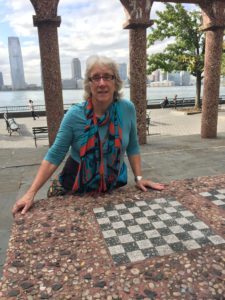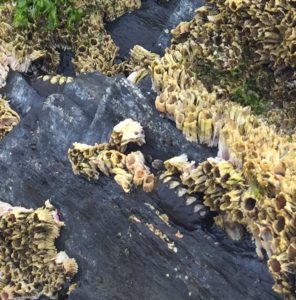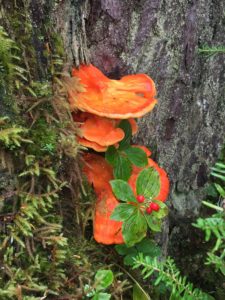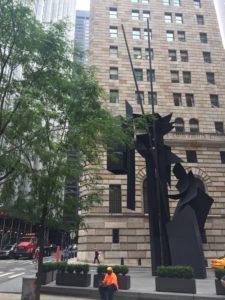
Kate Troll leans on stone chessboard in a pocket park off of Battery Park at the southern end of Manhattan Island, NY
Pocket Parks enrich a cityscape just as habitat diversity enriches a wild landscape. As Kate and I explored Manhattan for a few days, I tried to look at the cityscape through the eyes of NYC inhabitants. Impossible, of course. I won’t pretend that I know anything about cities from a city person’s perspective. In a sense I’m writing about something I know nothing about, and I’m sure I’ll prove it. I can only relate the city to my own experience.
A city is a landscape with habitats that support people, plants, and other animals. City habitats have their own energy, water, and food flow patterns; their own microclimates.

Intertidal Zonation provides diverse habitat for organisms like the Black Gumboot, barnacles & seaweed. Click image to go to detailed images and text: @bhfootloose Instagram
If you’ve followed me on Instagram (@bhfootloose), you know that I’m fascinated with habitat. Click the next two images if you want to learn more about the sea life that lives in habitats of the intertidal zone between high and low tide, or to read about the diverse plants in the small space at the base of a tree in the Southeast Alaska rainforest.

Moss and wood provide habitat for variety of plants. Click Image to read more at Instagram @bhfootloose
Walking with Kate through Battery Park and along the esplanade at the edge of saltwater on the west shore of Manhattan Island, I began to think about how much value pocket parks add to the city. Pocket parks are tiny spaces dedicated to the enjoyment of everyone. They may look like a garden, with plants and soil, or they may display sculpture, offer benches to rest on, or perhaps chessboards for public use.
And speaking of gardens, check out the image of the urban farm in Battery Park. I find it interesting that all of us can recognize one of these pocket parks when we see one. They contrast with the crammed buildings, the use of every square inch of space that defines a city, where land is astronomically expensive.
People live in habitats just like wild animals do. A diversity of habitats, makes a place attractive to a wider variety of people with their own needs, also similar to wildlife. It’s true, of course, that we must first fulfill our basic needs for food, water, and shelter. Beyond these, however different people have different needs. The closeness of city life may feel more secure than living and recreating in wild places. Or the reverse. People may seek solitude, a chance to be near birds and living plants, a meeting place for friends, enjoyment of art, a chance to relax… an infinite and personal list.
Like other public parks and facilities, pocket parks are for the PUBLIC, a critical concept. So much of the land, and structures of a city are privately owned. Pocket Parks belong to everyone, so they let each of us define them as a place of our own, shaped by and fulfilling our personal needs.

NYC Pocket Park: Louise Nevelson Plaza
What I heard from local residents and felt myself is that pocket parks made me happy. To walk along city streets of endless tall buildings without a gap except the streets, fully filled by stores and apartments, and then come upon a small open space with benches to sit on, perhaps with outdoor sculpture displayed, perhaps with nothing more than a shrubs and flowers (and inevitably birds and insects that I hadn’t seen for blocks), made me feel freedom, comfort, happiness.
So, my hat is off to every place that supports pocket parks. Thank you, NYC.

